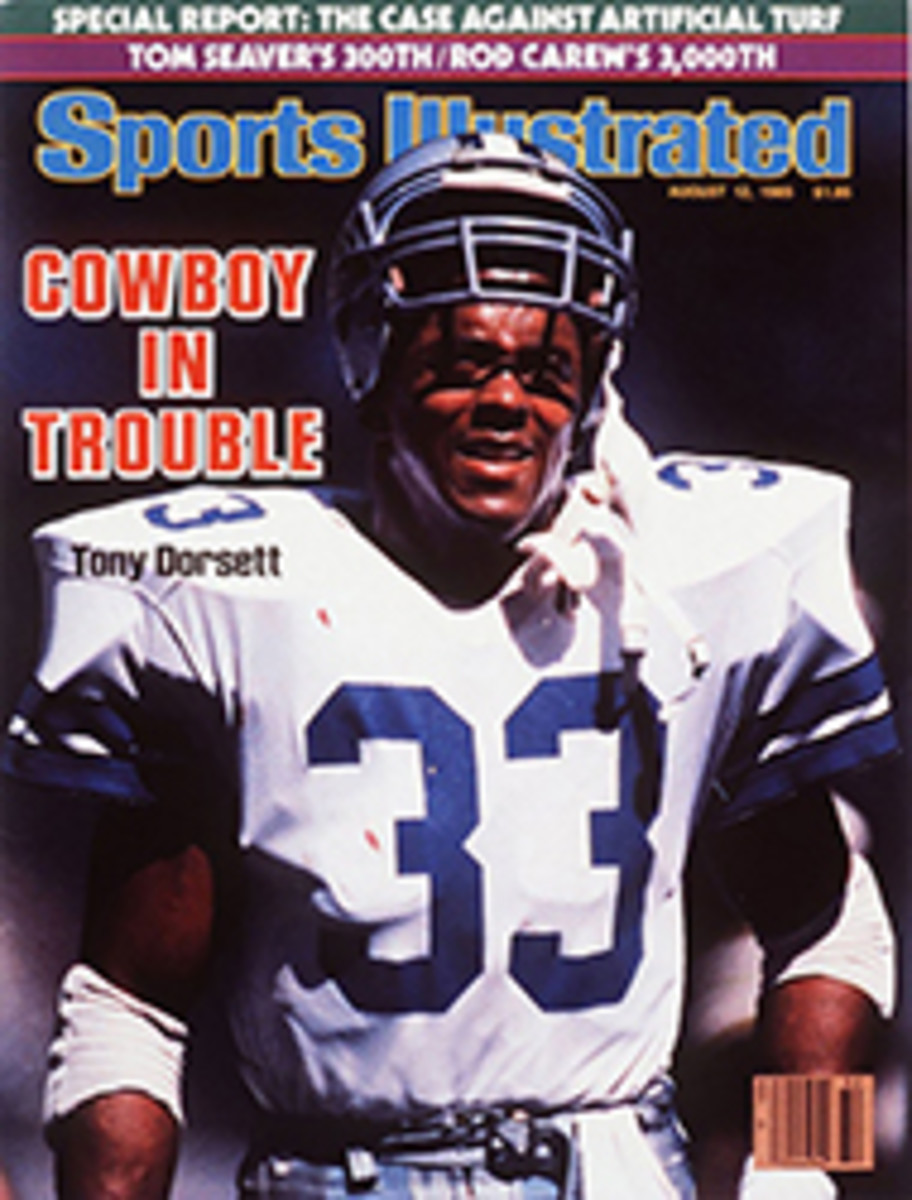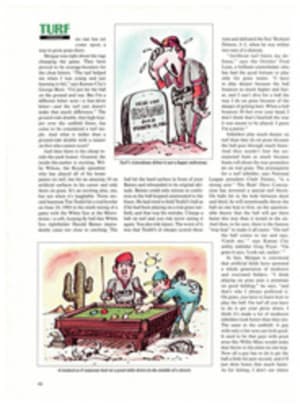
Tom Takes A Giant Step
When the ball plopped into the glove of his leftfielder, Reid Nichols, Tom Seaver doubled over in relief. Then he did a little jump for joy. Teammates were surging forward and 54,032 people were cheering, but for a moment he was alone, not knowing quite what to do. He was back in New York, where it all started, but the scene was a bit strange—his uniform said SOX across the chest, and the day started with a tribute to Yankee broadcaster Phil Rizzuto. Seaver had just beaten the Yankees 4-1 on a six-hitter to win his 300th major league game. It was another masterpiece in a gallery 19 years in the making, and the artist had only that brief instant to savor his work before the patrons arrived.
And arrive they did. His catcher, Carlton Fisk, lifted him off the ground, and the celebration began. Yankee fans and Mets fans alike—and maybe even the odd White Sox fan—began chanting "Sea-ver, Sea-ver" as the pitcher was mobbed by his Sox teammates. Fisk even gave him a fleeting kiss on the cheek before Seaver broke away and went over to his wife, Nancy, and his daughters, Sarah and Anne, in their field-level box. "Piece of cake," he told them.
Actually, it was a deftly shaded work of art that might have been entitled, Sunday in the Park with George Thomas Seaver. Over nine innings he scattered six hits, walked one, struck out seven and got out of several jams by mixing speeds and using guile. At 40, Seaver remains remarkably baby-faced, but he is the artist as an older man, one who no longer knows on a given day what colors he will find on his palette. "That's the challenge," he says. "That's what pitching is—using whatever you have to work with on any particular day—or inning, or situation. It's something that can change every time you go to the mound."
When Seaver finally took the mound after the festivities to honor Rizzuto, he found he had his good stuff. The White Sox failed to take advantage of early opportunities and trailed 1-0 going into the sixth. But then they touched Joe Cowley and Brian Fisher for four runs and left it up to Seaver. In the eighth, a two-out single by New York's Don Mattingly put runners on first and third, but Seaver told pitching coach Dave Duncan he wanted to finish, and Duncan—subbing for ejected manager Tony La Russa—allowed him to face Dave Winfield. Seaver went to a full count and struck out Winfield on a changeup.
He ran into trouble again in the ninth. Rookie Dan Pasqua opened with a single. Seaver struck out Ron Hassey, and Harold Baines made a leaping grab of a Willie Randolph liner against the wall in right. After walking Mike Pagliarulo on four pitches, Fisk and Duncan went out to the mound to see if everything was all right. Fisk later said that to keep Duncan from taking Seaver out, "I would have picked Dune up and carried him back to the dugout." Seaver thereupon got pinch hitter Don Baylor to hit his first pitch into the air in left, and Nichols settled under it for the final out. There was something else in the air: Seaver's number is 41, as is that of losing pitcher Cowley, and the score of both this game and the Mets' victory that day was 4-1. Whatever the score, the very idea of a players' strike seemed far away on Sunday afternoon.
With the last out, Seaver became the 17th pitcher to reach the 300-win plateau—the 13th righthander, the fourth oldest and the third to have pitched in both the American and National leagues. (He also improved his 1985 record to 12-8 and lowered his ERA to 2.92.) He is the only 300-game winner to have written three books on pitching mechanics and probably the first one able to cite Bernoulli's Law to explain why a fastball rises. "I'm a disciplined individual," he said the other day as he worked at The New York Times crossword puzzle. "I'm very organized, very able to block out distractions to my pitching." He dropped a trickle of tobacco juice into the little brass spittoon by his locker—neatly, of course—and wished he could remember the five-letter word for "absquatulate." (Scram.)
"I've never seen anyone so completely prepared physically and mentally, so aware of himself in game situations," says Fisk. "If not for his humanness—and all humans make mistakes—I don't think anybody would get any hits off him." Seaver's 300-189 career record (.613), achieved on Mets, Reds and White Sox teams with a combined record of exactly .500 (1,478-1,478), reflects precious few mistakes, though he seems to remember them all.
Years hence, of course, Chicago fans will recall this season for more than just Tom Terrific. The White Sox' other elder statesman, the 37-year-old Fisk, is leading the majors with 28 home runs—two more than he has ever hit in a complete season. He's bouncing around like a young man, stealing bases (11) and even tagging opponents out at the plate two at a time, as he did Friday after some bone-head baserunning by the Yankees.
When Seaver won his 299th on Tuesday night in Boston by going nine innings in a 7-5, 10-inning game, Fisk, the onetime Red Sox star, provided support by lofting a bases-empty fly ball into the leftfield screen at Fenway Park. It wasn't exactly the 1975 World Series revisited, but for a moment Fisk's New Hampshire stoicism melted away as he gleefully circled the bases to a standing ovation.
Seaver speaks more of Fisk's defensive contribution. "I've really been lucky in that I've worked with three of the best catchers of my era: Jerry Grote, Johnny Bench and now Pudge," he says. "All of them quickly came to an understanding of what I like and how I pitch. That's extremely important. In each case, our two minds started to work as one." So close is the thinking between the current battery-mates that Seaver almost never shakes off a Fisk sign, except when he and Pudge are intentionally trying to confuse the hitter. "He knows that I pitch more to my strengths than to a hitter's weaknesses," says Seaver. "Pudge also knows when to come out and give me a kick in the butt."
Not unlike Seaver, who in recent off-seasons has jogged, done light weight work and pitched into a net set up in the basement of his Greenwich, Conn. home, Fisk last October turned to a regimen of weightlifting, flexibility exercises, strict diet and Zen philosophy. Fisk's body has all too often been bruised and broken. Only three times in his 14 big league seasons has he totaled as many as 500 official at bats; he had to sit out much of last season with a pulled abdominal muscle. But thanks to off-season work with free weights, he gained 20 pounds and is in the finest shape of his career.
In the public mind, to be sure, Fisk will forever be the gritty soul of those Red Sox. Seaver, similarly, remains to most fans the heart of the Mets, for whom he won 198 games in two stints totaling 11½ seasons. He was snatched up by the White Sox in January of 1984 when the Mets, in what was widely taken to be a colossal blunder, failed to protect him in the free-agent compensation draft. Seaver was initially furious over the apparent gaffe—as were New York fans who still hadn't forgiven Met management for an earlier trade to Cincinnati—but he came to Chicago determined to make the best of it. And, as can be easily told from the familiar dirt stain on his right knee each time he pitches, he surely has. In fact, since the 5-13 disaster of 1982, when a sore shoulder had him contemplating retirement, Seaver hasn't missed a single start.
Still, with his Connecticut house just a commuter's drive north of Shea Stadium and his greatest memories reposing in that ball park, Seaver would rather have finished his career in New York.
"Chicago's not a home for me, certainly not," he says, typically direct. "I feel at home with the people I work with here; it's as good a group of guys as I've ever been with. And the city's fine. Chicago is a great city. But as far as living here, I feel like I'm a visitor." He and his wife and daughters rent a downtown Chicago apartment during the season and spend much of their time sightseeing, dining out and shopping. "We try to do things visitors would do," says Seaver.
"I probably enjoy pitching as much now as I ever have—more than I ever have—because I know more about it." And the 300 milestone? "I don't sit back and reflect on the significance of it. I don't dwell on it. There will be time for all that later. I'm not done yet." Seaver points out that he does have a new goal: "That," he says with a smile, "is to win number 301."
With 300 wins under his belt, Seaver went over toward the Yankee dugout to accept a silver bowl—a gift of the Yankees—from Phil Niekro, who is only six away from 300 himself. The two old masters together made quite a picture.
PHOTO
RONALD C. MODRA
TWO PHOTOS
RONALD C. MODRA
Anne waved to Pop during the game; afterward came a hug from Sarah as Tom's dad, Charles, father-in-law and Nancy looked on.
PHOTO
CHUCK SOLOMON
Seaver got a lift from Fisk, who has been carrying the White Sox offense all year.
PHOTO
NEIL LEIFER
Seaver doesn't seem to have aged much since the '69 Miracle Mets.

